Egypt
Old Members Trust Travel Grant Report – Chloé Agar, Year 2 BA Oriental Studies (Egyptology)
The professor of Egyptology, the other second-year from Harris Manchester College, and I flew from Gatwick to Luxor. There we joined a Thomson Nile cruise, which enabled us to travel between Luxor and Aswan and visit many sites from almost all periods of Egyptian history. This was chosen as the most economical and secure way of visiting the country in the present political circumstances. Sailing on the Nile allowed us to get a sense of the Egyptian landscape, and we started our hieratic class on board. Entry to the main sites was included in the tour package, but we also had significant opportunities to visit sites apart from the rest of the group. Whenever we visited a site with a group, we slipped away on entry and went round the site in more detail with Professor Parkinson.
Below is a list of the main sites that we visited and the context for study that we received for each one.
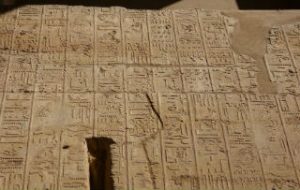 Karnak Temple, Luxor
Karnak Temple, Luxor
This is an extract from Tuthmosis III’s account of the Battle of Megiddo. This is particularly interesting to me because I like Eighteenth and Nineteenth Dynasty history more than that of any other period. We are going to read this FHS set text either at the end of this term or the beginning of Trinity. Seeing it at Karnak made it very clear why no good transcriptions have been made of it, as many parts are fragmentary and it is a huge text, covering the entire wall in the part of the temple in which it is found. It is also possible that not all of the text has survived, as a later wall seems to have been constructed over the end portion of it.
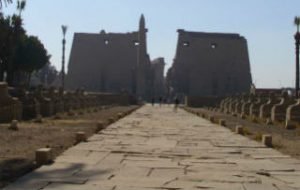 Luxor Temple, Luxor
Luxor Temple, Luxor
Luxor temple is much smaller than Karnak. It has beautiful images on the walls near the entrance pylons which depict the Southern Opet Festival. This was when the statue of the god Amun travelled from Karnak to Luxor via the Nile and back again, via the avenue of sphinxes which links the two temples. This avenue has been excavated far more than when I was last in Egypt nine years ago, so it was interesting to see how much more of it was visible. Standing outside Luxor temple along this avenue gave me a real sense of the scale of the ancient city Thebes, and what the procession of the festival must have been like to witness.
El-Silsilah
This is the narrowest point of the Nile, which we passed through in daylight on the way to Kom Ombo. There are quarries on the east bank which were used to build the temples of Luxor and Karnak. As the Nile is so narrow at this point, we passed very close to the shrines on the west bank and were able to take clear photographs of their façades.
Kom Ombo Temple
This temple is fascinating because it is the only temple in Egypt so far excavated which is dedicated to two gods simultaneously. Karnak is dedicated to various gods, but the site is really many temples built in close proximity to each other over time. Kom Ombo is dedicated to Horus and Sobek, and dates from the later part of ancient Egyptian history, when the Ptolemies and Romans ruled the country. It is interesting to see the cultural appropriation of the temple layout and hieroglyphic formulae in context; and we were able to study the style of the Greco-Roman reliefs. I have a personal affection for the mummified crocodiles. It was a pleasure to see that they have been moved from a small shrine building in the temple complex to a purpose-made museum, and that more have been added.
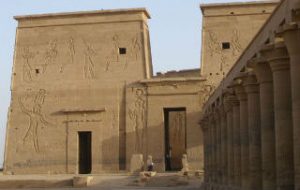 Philae Temple
Philae Temple
There is a collection of temples on this island. The most intact and impressive one is the Greco-Roman Period temple, which is dedicated to Isis. Even when the Byzantine emperors closed down all of the other temples, the cult of this one survived because the Nubian tribes still worshipped the powerful, maternal figure of the goddess. We examined the last known dated hieroglyphic inscription in the gateway of Hadrian, and the carvings made when the temple of Isis was converted into a Coptic church. This temple is one of the great success stories of archaeology, because when the High Dam was built in the 1960s, UNESCO surveyed and moved as many monuments as possible to save them from being submerged under Lake Nasser. Consequently, the island on which Philae stands is not the original one, but it is not possible to tell that everything is slightly closer in proximity than it would have been on the other island.
Aswan High Dam and Friendship Monument
This gave us a chance to learn about the modern periods of Egyptian history and the modern environment. The view of Lake Nasser is beautiful, but this is bitter sweet because there are many monuments which UNESCO was unable to save. However, the dam has secured the Egyptian economy. The Soviets funded the dam, so the Friendship Monument is dedicated to the relationship between Egypt and the Soviet Union. It is a simple but striking piece of sculpture based on the lotus flower. However, Egypt’s water supply is under threat and the country is currently in negotiation with Ethiopia to resolve this. As the final of the ten countries along the Nile, Egypt has the right to veto any projects proposed by the other countries. However, Ethiopia is continuing to build its dam. As the first country on the river, completion and use of this project would be disastrous for the other nine countries.
Nubian Museum, Aswan
Egyptian history is a brilliant example of colonialism. This is an anachronistic concept, but it is easy to understand why it is applicable because Egypt spent its entire history raiding and conquering parts of Nubia. This was not entirely one-sided, however, as the Twenty-Fifth Dynasty of Egypt happened at a weak time for the Egyptians themselves, and consisted of Nubian rulers. This museum is an excellent way to follow the entire history of the relationship between these two countries. The photographs from the inside are a little dark, but there are many beautiful stelae and statues in the garden, including recently installed megalithic structures from Nabta Playa.
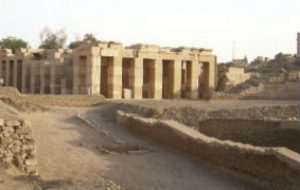 Elephantine, Aswan
Elephantine, Aswan
We visited the island town-site of Elephantine by ourselves. This site has been continually inhabited since the Old Kingdom at the beginning of Pharaonic Egypt. We have read in texts that the local ruler of Elephantine was a powerful political player in Egypt because traditionally this was the country’s southern-most point. I had never realised how big that this island actually is, and seeing it makes its role as a border-post and governing site of the south far easier to understand. The site is excavated by the German and Swiss teams and is very well presented to visitors; we saw the Old and New Kingdom Satet temple, the shrine to Heqaib, the temple of Khnum, the governor’s palaces, the Nilometer and the newly restored Old Kingdom town walls. The winding alley ways of the Middle Kingdom town were a contract with the more planned settlement of Deir el-Medina.
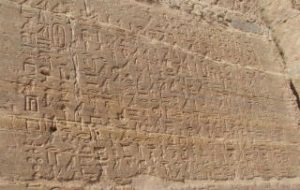 Qubbet el-Hawa, Aswan
Qubbet el-Hawa, Aswan
This is the site of many high elite burials from the Old to New Kingdoms. It was used as a site for a monastery and a basilica by the Copts, and there is a sheikh’s tomb on the peak. We visited this site by ourselves, and Professor Parkinson gave us an excellent survey of all of Egyptian history and we became very familiar with the layout of tombs. The view from the peak is spectacular in all directions, and it is possible to see the High Dam on the horizon and the cataract beneath the British Dam. The photograph is an extract from the letter of king Pepy on the façade of the Old Kingdom tomb of Harkhuf. Next year we will learn Old Egyptian and read it as an FHS set text. We walked back through the desert valleys, which emphasised why the Nile is still so important for the support of life in Egypt.
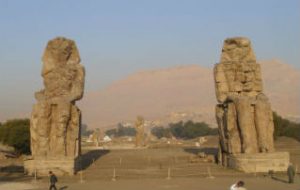 Colossi of Memnon, Luxor West Bank
Colossi of Memnon, Luxor West Bank
This was visited during the official half day spent on the West Bank at Luxor. There is not much left of this temple of Amenhotep III because he built it on the Nile floodplain. There has been a lot of excavation since I was last in Egypt, and it was heartening to think that more statues and walls of this temple are coming to light and being restored by the team led by Hourig Sorouzian. It appears that it was a huge temple, so it will be interesting to see how much more is found there. We examined the Greek graffiti recording the imperial visit by Hadrian.
Valley of the Kings, Luxor West Bank
There is no photograph because photography here is banned to preserve the tombs. The tombs are filled with incredible colour and the images and writing inside them are still crystal clear. Although all Egyptian rock-cut tombs are fundamentally of the same design, it is interesting to see how the use of the space shifted across the dynasties. We went into two Eighteenth Dynasty tombs (Tuthmosis III and Horemheb) and one from the Nineteenth (Merenptah), as tickets are valid for three tombs. I enjoyed looking at the differences between the tombs of this period. Tuthmosis III’s tomb was the most well hidden, being situated high up a cliff. The simple linear hieroglyphic writing and images in his tomb are interesting because they are so different from those in other tombs. Horemheb’s tomb was brilliant because it was unfinished. It was possible to see all of the phases of wall decoration as we walked around the tomb. There were labels on each wall saying ‘west’, ‘opposite the king’ etc. so that the workers filling the tomb with Horemheb’s possessions would know where everything was supposed to go. Merenptah and Horemheb’s tombs were much more colourful and detailed than Tuthmosis III’s.
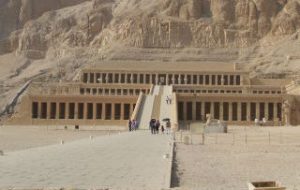 Deir el-Bahri, Luxor West Bank
Deir el-Bahri, Luxor West Bank
Hatshepsut’s funerary temple easily has the most beautiful façade of all of the ones which we visited. There was a lot to see here, and all levels of the temple are now open to visitors. The tour guide’s trip to the West Bank was excellent for me because it involved a lot of material from the period in which I am interested. This temple also contains the Punt Colonnade, documenting an expedition to this land south of Egypt. There are similar passages in The Tale of the Shipwrecked Sailor, which we read last year, and will read again this term in its original, cursive hieratic form as an FHS set text.
Deir el-Medina, Luxor West Bank
This was the village for the people who worked on the tombs in the Valley of the Kings, and its unique combination of archaeology, artefacts and texts makes it a major source for social and cultural life in the Ramessid Period. This was great for textual context because two of our Late Egyptian FHS set texts come from the same people. The Contendings of Horus and Seth was part of the library of Qenherkhepeshef, and this term we will read the will of his wife Naunakhte; both were discovered in the cemetery outside the village walls. We also saw the grand puits, where many ostraca were discovered, and then walked towards Deir el-Bahri, through the valley of colours, an ancient source of ochre, past some Middle Kingdom elite tombs.
Tombs of the Nobles, Luxor West Bank
We visited three tombs of officials separately from the tour group. There is no photograph because photography is also banned in these tombs. It was interesting to compare the layout of the royal tombs with the non-royal ones. The non-royal ones are more plain, but the workmanship inside them is no less impressive and they contain the scenes of ‘daily life’.
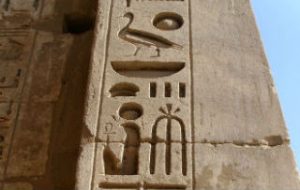 Medinet Habu Temple, Luxor West Bank
Medinet Habu Temple, Luxor West Bank
On the day of our flight home we visited Medinet Habu.
This is the most intact temple on the Theban West Bank, with impressive remains of pigment. Most of it was constructed by Ramses III on an earlier site. It is possible to see the layout of the small palace in which the king would have stayed when visiting this temple. The political situation in Egypt during his reign is demonstrated by the depth of the hieroglyphs carved into the temple walls. They are so deep that those wishing to erase the king’s name would struggle. This supports what we have learned about him in lectures because he was supposedly assassinated by his harem, and we may read texts concerning the subsequent trials.
Dra Abu el-Naga Excavations, Luxor West Bank
On our last day we also had the chance to see two excavation sites. We were invited to visit the two tombs being excavated by the Macquarie Theban Tombs Project. This was interesting because the first tomb’s decoration was almost all writing, except for one wall which bore an offering scene image. We were taken down by Professor Boyo Ockinga to see the burial chamber and the sarcophagus. Seeing a tomb mid-excavation was very special, and the amount of reconstruction which the Australian team had had to do put the complexity of excavation into perspective. We also visited the Spanish Djehuty Project, which is excavating tens of tombs in an area of the necropolis used by the Seventeenth Dynasty royal family. We were guided by its leader, Dr Jose Galan, and then taken into a tomb which had tomb texts and graffiti covering almost all of ancient Egyptian history, including Demotic and Coptic graffiti.
Find out more about the range of travel grants and scholarships available to assist Univ students on our Travel Grants page or read further travel reports.
Published: 6 November 2016
Explore Univ on social media
